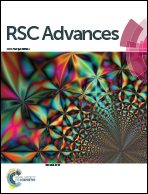A facile and highly chemoselective synthesis of 1-thia-3a,6-diaza-benzo[e]azulen-3-ones by 7-exo-dig/trig halocyclizations†
Abstract
This manuscript describes a study on relatively unexplored halogen mediated 7-exo-dig/trig cyclization reactions of 2-(2-amino-aryl)-3-prop-2-ynyl/allyl-thiazolidin-4-ones for the formation of thiazole condensed 1,4-benzodiazepines in good yields. The reactions are facile, chemoselective and involve the use of simple substrates leading to synthesis of diversely functionalized 1,4-benzodiazepines. The synthesis of such condensed 1,4-benzodiazepines is important in terms of their usefulness as biological active agents.
![Graphical abstract: A facile and highly chemoselective synthesis of 1-thia-3a,6-diaza-benzo[e]azulen-3-ones by 7-exo-dig/trig halocyclizations](/en/Image/Get?imageInfo.ImageType=GA&imageInfo.ImageIdentifier.ManuscriptID=C6RA23493C&imageInfo.ImageIdentifier.Year=2016)

 Please wait while we load your content...
Please wait while we load your content...